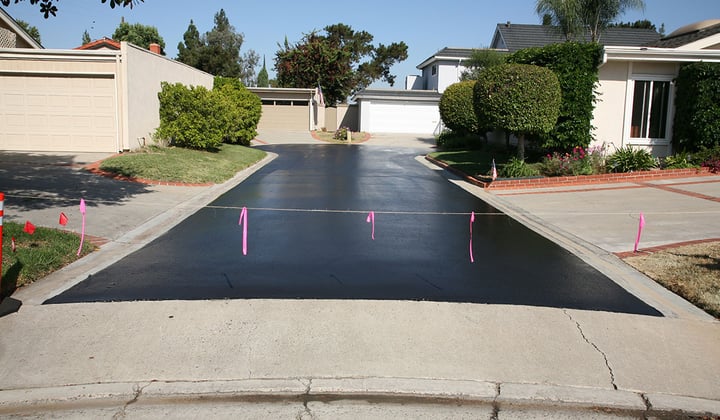Elevate Safety And Security and Appeal: Angled Parking Area Solutions with Asphalt Sealing
Elevate Safety And Security and Appeal: Angled Parking Area Solutions with Asphalt Sealing
Blog Article
Warm Mix Asphalt: A Lasting Service for Sidewalk
Warm Mix Asphalt (HMA) has emerged as a leading lasting selection for pavement solutions, providing a myriad of cutting-edge innovations and environmental advantages. As the need for environmentally friendly building and construction practices expands, checking out the subtleties of HMA's sustainability can offer useful insights into the future of pavement options.
Ecological Benefits of Hot Mix Asphalt

In Addition, Hot Mix Asphalt helps to minimize urban warm island impacts. Its dark color soaks up sunshine, decreasing the quantity of heat mirrored back into the atmosphere compared to lighter-colored sidewalks. This can decrease ambient temperatures in metropolitan areas, reducing the demand for air conditioning and eventually lowering power intake.
In addition, Hot Mix Asphalt contributes to enhanced stormwater monitoring. Its porous nature allows water to recharge and infiltrate the sidewalk groundwater materials, minimizing overflow and the threat of flooding. These ecological advantages make Hot Mix Asphalt a lasting choice for paving freeways and roads.
Power Efficiency in HMA Manufacturing
Is energy effectiveness an essential consider the production of Warm Mix Asphalt (HMA)? Absolutely. Energy plays a considerable function in the production of HMA, influencing both expense and ecological sustainability. One key aspect of power performance in HMA production is making use of warm mix asphalt (WMA) modern technologies (commercial parking lot paving). WMA enables the mixing and placement of asphalt at reduced temperatures compared to standard hot mix asphalt, causing reduced energy intake during production. This process not just lowers fuel use but likewise decreases greenhouse gas exhausts, making it an extra eco-friendly alternative.
Moreover, improvements in plant technologies have led to even more energy-efficient HMA production processes. By maximizing power usage in HMA production, the sector can decrease its carbon impact while maintaining top notch pavement materials.
Recyclability of Warm Mix Asphalt
The recyclability of Warm Mix Asphalt (HMA) is a pivotal element of its sustainability and lasting environmental effect. HMA is just one of the most recycled materials in the United States, with over 100 million bunches of redeemed asphalt pavement (RAP) being reused every year in brand-new pavement building. Reusing HMA supplies several environmental benefits, such our website as minimizing the demand for virgin products, lowering energy consumption during manufacturing, and lowering the quantity of waste sent out to garbage dumps.
The process of recycling HMA includes milling the existing sidewalk, crushing it right into smaller sized items, and mixing it with brand-new aggregate and asphalt binder to develop a recycled mix. In general, the recyclability of HMA plays a considerable duty in promoting sustainable techniques within the sidewalk industry.

Long-Term Performance of HMA
Asphalt pavements demonstrate toughness and strength over an extended period, reflecting the long-lasting efficiency of Warm content Mix Asphalt (HMA) The long life of HMA can be credited to its ability to withstand rush hour loads, severe weather, and the impacts of aging. Research studies have shown that well-designed and properly built HMA sidewalks can last for twenty years or more with routine maintenance. The key to taking full advantage of the long-lasting performance of HMA hinges on using high-grade materials, following ideal techniques in building, and executing effective upkeep methods. Proper drain, regular inspections, and prompt repairs are crucial for maintaining the structural integrity of HMA pavements with time. Additionally, advancements in HMA modern technology, such as using polymer-modified binders and warm mix asphalt, have better enhanced the longevity and durability of HMA pavements. By focusing on quality building and maintenance methods, HMA remains to verify itself as a lasting and affordable service for long-lasting pavement framework.

HMA: Resilience and Sustainability
Showing both durability and sustainability, Hot Mix Asphalt (HMA) has actually come to be a cornerstone in the building of long-lasting sidewalk infrastructures - regrading. HMA's longevity comes from its ability to stand up to heavy tons, harsh weather, and high website traffic volumes, making it a trustworthy choice for roads, highways, and airport paths. The make-up of HMA, which usually consists of aggregates, binder, and filler, plays a vital duty in improving its long life and resistance to tear and put on
Moreover, HMA's sustainability depends on its recyclability and energy-efficient manufacturing process. The capability to recycle reclaimed Discover More asphalt sidewalk (RAP) in new HMA mixes lowers the demand for virgin products and reduces the ecological effect of pavement building and upkeep. Additionally, the energy performance of generating HMA exists in its reduced mixing temperature levels contrasted to various other pavement materials, resulting in minimized power intake and greenhouse gas emissions.
Conclusion
Finally, warm mix asphalt (HMA) uses a lasting service for sidewalk with its ecologically friendly qualities. HMA's recyclability, energy effectiveness in production, and long-lasting longevity make it an environmentally friendly option for road construction. By conserving natural deposits, reducing waste, and decreasing greenhouse gas exhausts, HMA plays a crucial function in promoting sustainability in infrastructure growth. Its capability to alleviate metropolitan warm island results further emphasizes its importance in producing resistant and environmentally aware pavement systems.
HMA is one of the most recycled products in the United States, with over 100 million bunches of recovered asphalt pavement (RAP) being reused annually in brand-new sidewalk construction.The process of reusing HMA involves milling the existing pavement, squashing it into smaller sized items, and mixing it with new aggregate and asphalt binder to produce a recycled mix.Asphalt sidewalks show resilience and strength over an extensive period, mirroring the lasting efficiency of Hot Mix Asphalt (HMA) Furthermore, developments in HMA innovation, such as the usage of polymer-modified binders and cozy mix asphalt, have actually better enhanced the durability and durability of HMA sidewalks. The capacity to recycle reclaimed asphalt pavement (RAP) in brand-new HMA mixes minimizes the need for virgin materials and decreases the environmental impact of pavement building and construction and maintenance.
Report this page